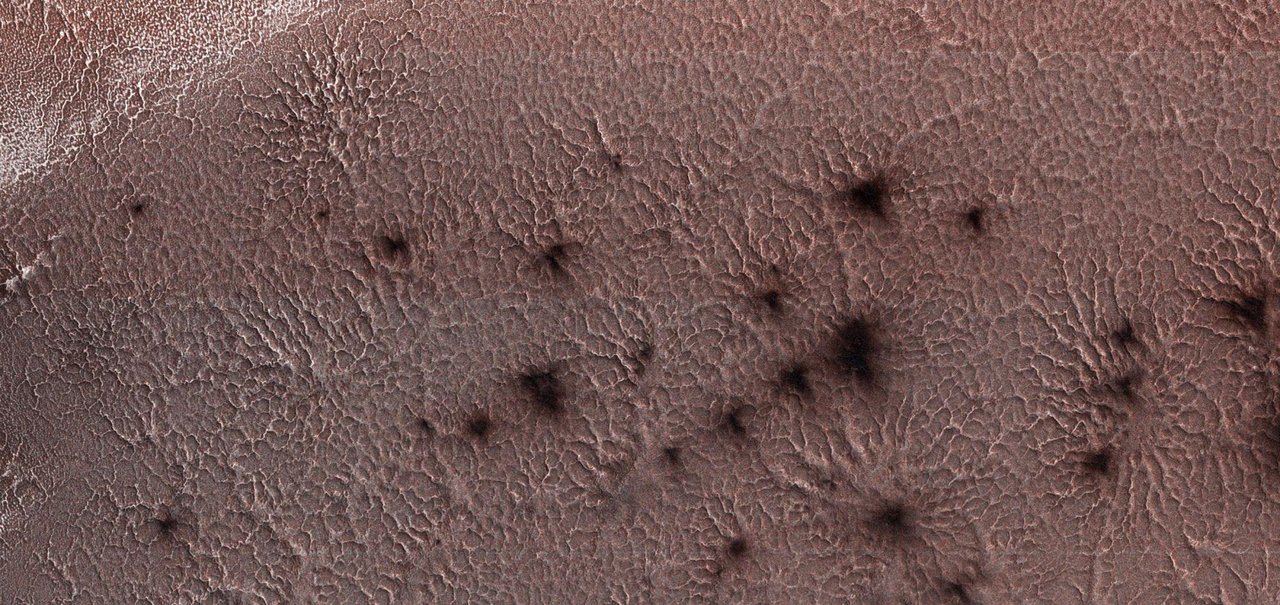Every week, TecMundo and #AstroMiniBR select the most interesting and up-to-date news in astronomy to bring you the latest news from our vast universe. Check it out!
1. Lab-Replied “Spiders” from Mars
One of the phenomena The most interesting thing on Mars are the formations known as “spiders” (or “araneiformes”).They were first discovered in 2003 through images taken by orbital probes. The formations occur mainly in the southern hemisphere of Mars and have attracted the attention of scientists for decades.
These structures form when carbon dioxide ice in the Martian source sublimates directly into gas, creating cracks in the surface and releasing jets of dust and sand that form characteristic web-like formations.
This month, NASA scientists used the DUSTIE system at the Jet Propulsion Laboratory (JPL) to recreate these “spiders” in the lab for the first time. By simulating the low-pressure conditions and extremely cold temperatures found in the polar regions of Mars, and by heating simulated Martian soil covered in CO2 ice, the researchers were able to replicate gas jets and spiral formations that resemble patterns observed on Mars.
This experiment Not only does it confirm the “spider” formation model, it could also provide valuable information for future missions to Mars.A better understanding of these geological processes will help improve landing sites and the tools needed to more effectively study the Martian surface.
2. The Beautiful Serpent Nebula
Impressive images from Captured by the James Webb Space Telescope, the Serpent Nebula revisits a fascinating discoveryAstronomers have observed streams of gas from star formation for the first time, confirming long-held theories about star formation.

These streams of gas, known as bipolar jets, are ejected by newborn stars and collide with surrounding gas, creating visible clouds of molecular hydrogen and carbon monoxide. The alignment of these streams suggests that the stars were rotating in a common direction during their formation process, which is consistent with the rotation of the gas clouds that collapsed to form these stars.
This discovery will not only help us better understand the dynamics of the birth of young stars, but also providing a glimpse into areas that were previously invisible to optical telescopes due to the dense dust in the surrounding area.
3. Revisiting the Andromeda Galaxy

Hubble Space Telescope captured a new, detailed image of the Andromeda Galaxy, one of our closest galactic neighborsQ. The galaxy, located about 2.5 million light-years from Earth, has been re-presented in a beautiful image that highlights vast regions of ionized gas that are fueling the formation of new stars.
Studies like these are crucial to understanding how galaxies evolve over time, as well as providing new insight into the object that will mark the future of the Milky Way, as these galaxies are on a collision course that is predicted to occur in the next few years, 6 to 10 billion years.
Did you like the content? So always stay up to date with the latest astronomy news on TecMundo. See you next Monday!
Source: Tec Mundo
I’m Blaine Morgan, an experienced journalist and writer with over 8 years of experience in the tech industry. My expertise lies in writing about technology news and trends, covering everything from cutting-edge gadgets to emerging software developments. I’ve written for several leading publications including Gadget Onus where I am an author.











